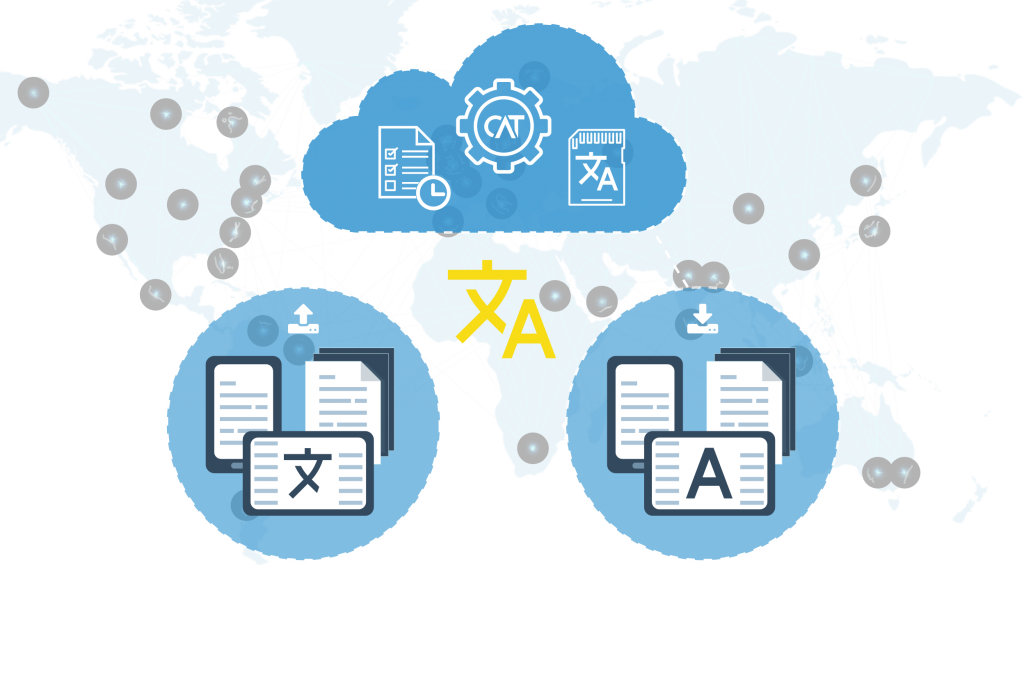Machine Translation
Implementing machine translation (MT) can be a solution for companies that need a cost-effective way to translate a high volume of content that has low visibility or does not necessarily need to be of high quality. For instance, companies can consider applying MT on low-visibility content such as user-generated content on social media or product descriptions on e-commerce platforms.
MT Training
One way to implement MT is to simply connect your website, app, software, etc. to an already existing MT, such as Google MT or Microsoft Translator. If you have more specialized content and/or terminology, you could also make use of NMT and develop your own model. Most Language Service Providers have domain-specific MT models (e.g. finance, automotive, etc.) that can be further customized based on the clients’ needs.
The basic rundown of the MT training process is:
- The engine is usually trained, tuned, and tested using previously translated content (parallel texts) done by human translators (to ensure accuracy), and based on these segments, the engine uses algorithms to match target language segments as closely as possible to the source segments.
- The more content is fed into the machine engine, the more it “learns” and improves
- “Garbage in, garbage out”
- The quality of the content fed to the engine is highly important for it to produce accurate and high quality translations
The main advantages of training your own MT are:
- The more you train the MT, the more accurate it will become.
- The more specialized content you use to train the MT, the faster the MT will be able to learn your preferred style and terminology.
MTPE
You can achieve better results from the MT when there are human translators who can post-edit the machine translation output (this process is called MTPE).
This is a common alternative to traditional human translation. Rather than have the human translator translate all the content, the human reviewer only needs to edit the target content that the MT produces to make it sound more fluent and natural to the target audience. This process is usually faster than human translation, unless the MT generates mostly “garbage” (e.g. content that has a lot of spelling and grammar errors, omission errors, meaning errors, style errors, etc.). In this case, it may actually take more time for the human reviewer to re-translate the content.
Pros and Cons of using MT
If you’re considering translating content on a large scale, MT is definitely a time-saving and cost-effective solution that’s worth looking into. However, technology still has its limits and MT is still not perfect. We will explore below the benefits and drawbacks of using MT below.
The main advantages of using MT are that it:
- Produces translations very quickly
- You can publish translated content into the market a lot faster than if you were using the human TEP process.
- In short, you can have faster turnaround times for a large volume of content into many different languages.
- Cuts down on translation cost
- Machine translation is usually followed by post-editing from human editors, which is less costly than translators. However, as editors only check for major accuracy and fluency errors, the quality of the translated content might be lower than one that is 100% translated by human translators.
However, MT is not an ideal solution for content that requires a higher quality output. For example, with marketing content, mistranslations can lead to ineffective marketing campaigns, misunderstandings regarding the product/service and/or company, and even a damaged brand reputation, all of which lead to a loss of profit.
The main disadvantages of using MT are that it:
- Produces mostly “word-for-word” translations
- Thus, it is not that great at picking up linguistic and cultural nuances in a text.
- Does not always produce accurate and/or fluent translations
- It sometimes cannot create proper sentence structures or pick up on the correct context (and thus generates a mistranslation)
- Cannot do transcreation
- Transcreation work still relies heavily on human translators.
- Does not work well with long and/or complicated sentences
In short, MT is not a good option for content that has:
- Complicated sentences or sentence structure
- Subject matter/domain that is strictly regulated
- E.g. life science, pharmaceutical or medical content
- Highly nuanced content (culturally, contextually, etc.)
- E.g. marketing content, subtitles, literature, etc.
- Local dialects
- Slang
- Profanity




